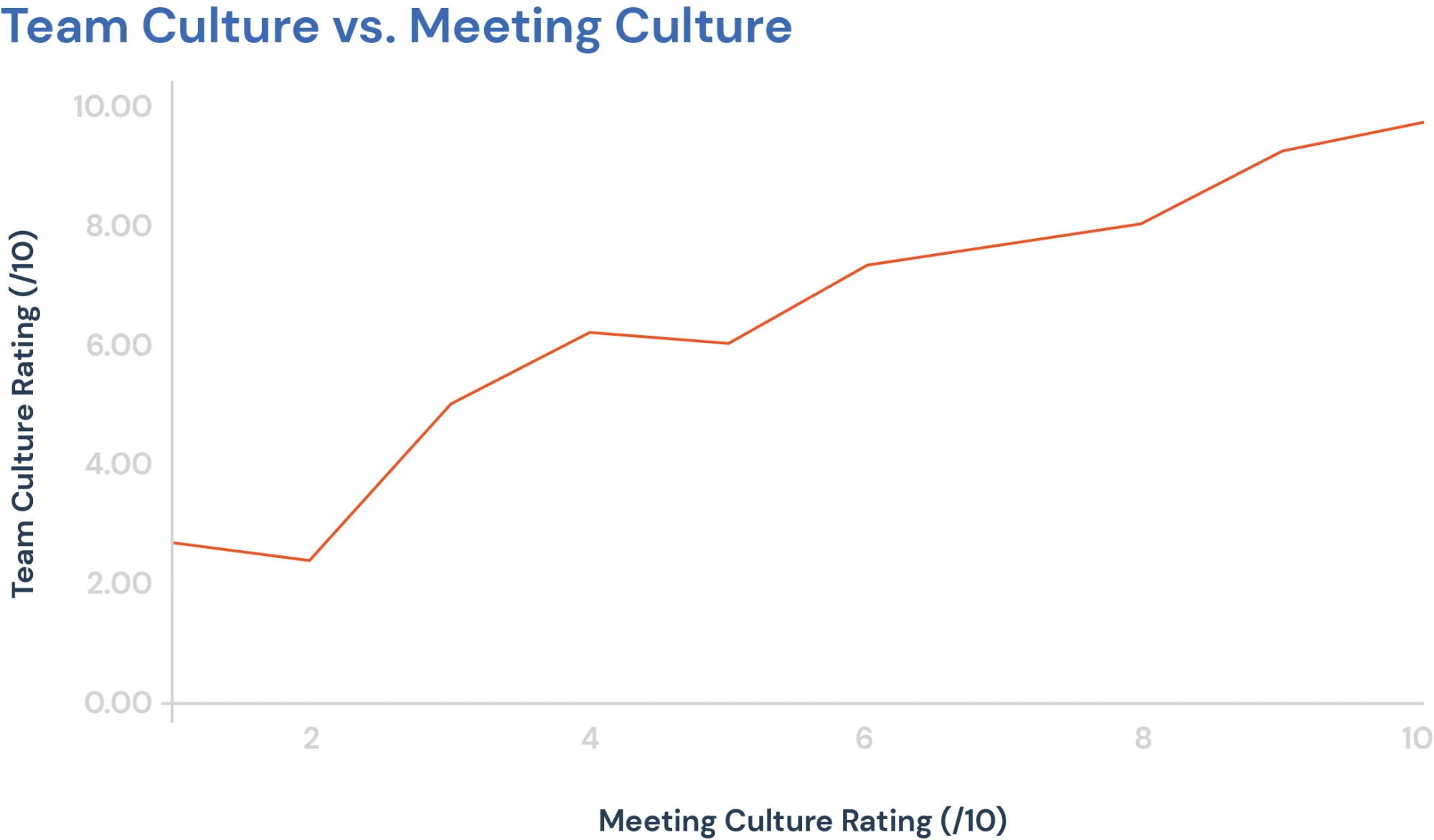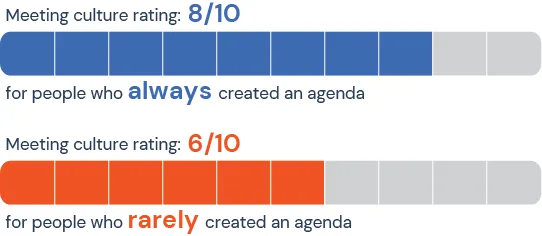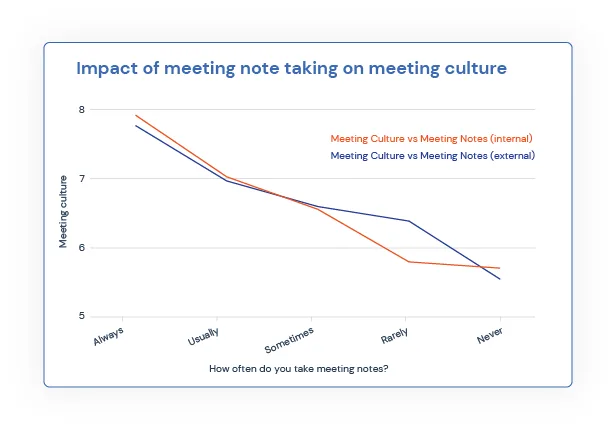Table of contents
This isn’t about how to dress to impress in remote meetings. And let's be honest — we’ve all been lax about the slacks lately.
We use “PANTS” to facilitate more effective meetings.
It's an acronym. And it's rooted in hard numbers.
Calendly helps set meetings efficiently and Hugo ensures better follow-up through centralized, actionable meeting notes. Making sure the meeting itself is productive is all about process.
Online meetings can be longer, more emotionally exhausting, and less productive than in-person meetings.
And that’s where PANTS steps in.
Here's the abbreviation for our vital meeting methodology:
Purpose
Agenda
Notes
Tasks
Shared
It seems obvious, but how many meetings do you attend that miss some of these elements?
We’ve learned that missing just one can have a greater impact than you would expect.
Direct correlation: company culture and meeting productivity
In a recent study of 500 individuals attending more than five weekly meetings, we found a direct correlation between their satisfaction with company culture and the meeting culture. Meaning, if your employees aren’t happy with the culture of the company, they’ll bring a negative attitude to meetings, which spreads pessimism and lack of motivation.
It can be overwhelming to create structures and processes to improve company culture at large — but it’s simpler to improve meeting culture first and work from the ground-up.
Respecting other people’s time
No matter what type of meeting you have, stating a clear purpose and an agenda ahead of time helps set expectations of what you’re going to accomplish and why this meeting is worth (specifically) their time.
In the PANTS acronym — Purpose and Agenda.
Having a Purpose means more than just having a reason to meet. It’s your definition of the meeting’s mission.
Attendees should have a clear understanding of why you’re meeting, what you’re looking to get out of it, and market to determine whether the meeting was a success or not.
The Agenda is the meeting’s blueprint and respects the progression of the meeting. It should outline talking points, decisions to be made, necessary preparation and inputs and expected outcomes too.
It’s a force for ensuring all attendees come prepared, that the meeting achieves its purpose and everyone feels that the meeting was worth the time.
When you think about people’s need for respect, particularly in their professional life, it’s no wonder that setting an agenda made a difference. We found that employees who rarely set agendas for meetings were 23% less satisfied with the culture in the meetings than those who always set agendas.
By the way, another way of respecting people’s time is by not inviting them to unnecessary meetings. At Hugo, there's a 4-hour weekly cap on internal meetings, which we achieve by only inviting attendees who need to contribute to debate, discussion and decision-making.
That doesn’t mean others miss out though, as we have a strong culture of sharing meeting notes and takeaways with the rest of the team.
Getting stuff done
Talk is cheap, so they say; but in a company, talk is expensive. Keeping track of what was said, the takeaways and the actions coming out of a meeting is what transforms talk into results.
People want to feel productive, and they want to feel they can count on other people in their company. If they are going from meeting to meeting without clarity, it breeds distrust. Even worse is coming back to a meeting and disagreeing about what they promised in the last meeting — or simply rehashing the previous meeting.
Retired U.S. Army General Stanley McChrystal refers to this as “shared consciousness” in a team. In his book, "Team of Teams," he explains how he was able to bring disparate branches of the military together to create a successful fighting force against Al Qaeda forces. The shared consciousness is the ability of a team to predict how their teammates will perform. If you trust your teammates to do their part, you can focus on your part.
Company culture erodes when people can’t trust one another to make commitments and take actions. That’s where the N and T come into play. Take Notes and set Tasks—with specific individuals assigned to the tasks.
When the information is recorded and tasks are assigned, people are held accountable for their commitments. You can trust that people will either perform the tasks and take the actions, or they will be held accountable. When everything is recorded transparently, all meeting participants can look back and see that this was, in fact, what they agreed upon in the meeting.
The secret is simple. Create a culture of taking meeting notes, with tasks clearly articulated and assigned.
Better still, centralize those notes and tasks, so there is one source of truth for meetings in your organization. (The best of the best companies do this.)
In a company where people deliver on their promises, employees experience trust in one another. They can set a purpose for a meeting and know they have a good chance of accomplishing that purpose.
Again, our findings were conclusive. Where people rarely set tasks in meetings, the culture was rated poor: 5 on a scale of 1–10. Even more telling was that people who rarely take notes said that they also rarely got action items done, rating the actions taken at 1.5 on a scale of 1–10.
In other words, no notes = no work. And that doesn't translate well when it comes to company culture.
Take a look at the numbers charted out.
Transparency and effectiveness
Sharing is the final step in the PANTS methodology, and just like the other meeting tips, it directly translates into company culture as a whole.
When people take notes and share them with others, nobody feels left out and nobody has to waste time. If notes are published from every meeting, even those who missed the meeting are able to benefit. People don’t feel that they need to attend meetings just to stay informed: the information is available.
A senior engineering manager at Atlassian observed the importance of transparency in the company culture. “When I see people freaking out about an announcement or something, it often seems they’re just freaked out that they didn’t find out about it earlier,” she said.
Furthermore, with public and shared notes, teams can know if there is overlap between their work and that of other groups. Sharing increases cross-team coordination, making the company more effective.
Transparency and inclusion further increase trust and effectiveness. If information is public, nobody feels “left out” or siloed in their department. They can search for and find information relevant to their role easily, and get the pertinent details quickly.
People across departments make better decisions, because they know what their colleagues are doing. Meeting organizers can ensure that even those who should not attend a full meeting are able to get the tidbits of information that are most relevant to them through good note-taking and sharing of information.
PANTS for all
Effective meeting habits seep into the entire company culture, so if you are serious about your productivity and company culture, starting with your PANTS on is a perfect fit.
Creating great meetings requires the same skills as creating a great culture: planning, goals, accountability and transparency. You don’t have to start with deep processes like creating “values statements” or bringing in expensive consultants for multi-day offsite retreats.
Something as simple as taking five steps for more effective meetings can seep out into the entire company culture. The PANTS methodology has ripple effects on every aspect of company culture.
Learn more about what we found in our research or download your free copy of the Vital Meetings Methodology.
Get started with Calendly
Related Articles
Don't leave your prospects, customers, and candidates waiting
Calendly eliminates the scheduling back and forth and helps you hit goals faster. Get started in seconds.
Calendly eliminates the scheduling back and forth and helps you hit goals faster. Get started in seconds.




